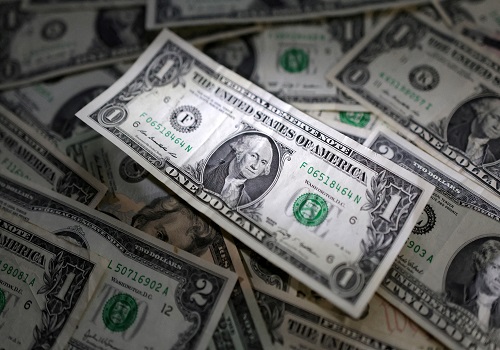Copper trading range for the day is 770.9-807.3 - Kedia Advisory

Follow us Now on Telegram ! Get daily 10 - 12 important updates on Business, Finance and Investment. Join our Telegram Channel
Gold
Gold prices fell by -0.31% to settle at 71,381 as traders reassessed the economic and monetary outlook amid mixed economic signals. The ISM Manufacturing PMI indicated a fifth consecutive month of contraction in U.S. factory activity, sparking concerns over the impact of elevated interest rates on the U.S. economy. These concerns have heightened anticipation for upcoming economic data, particularly the JOLTS report and the broader jobs report, which are expected to provide further insights into labor market conditions and guide expectations for the Federal Reserve's potential rate cut later this month. Market participants have already factored in a rate reduction on September 18th, with a 40% probability of a 50 basis point cut, while a smaller 25 basis point decrease remains more likely at around 60%. In the physical gold market, Indian gold discounts widened to their highest in six weeks as a price rebound dampened consumer demand. Other Asian markets, including Singapore, Hong Kong, and Japan, also saw varying levels of premiums and discounts, reflecting a cautious market sentiment. The World Gold Council noted that India's gold demand fell by 5% in the June quarter compared to the previous year, but a recovery is anticipated in the second half of 2024 due to a correction in local prices following a significant reduction in import taxes and favorable monsoon rains. Technically, the gold market is experiencing long liquidation, with a -1.83% drop in open interest, settling at 15,701 contracts. Prices are currently supported at 70,995, with a potential test of 70,615 if this level is breached. On the upside, resistance is likely at 71,760, and a move above this could see prices testing 72,145.
Trading Ideas:
* Gold trading range for the day is 70615-72145.
* Gold dropped as dollar index seen near to the highest level in about two weeks.
* The ISM Manufacturing PMI, showed factory activity contracted for a fifth consecutive month.
* Indian dealers widen discounts to $8/ounce, a six-week high
Silver
Silver prices fell by 1.54% to settle at ?83,252 as markets digested recent economic data to gauge the potential magnitude of rate cuts by the Federal Reserve in its upcoming cycle. The Core PCE price index, the Fed's preferred inflation gauge, increased by 0.2% in July, aligning with expectations and keeping rate cut bets intact. The market anticipates a total of 100 basis points in cuts across the Fed's remaining meetings this year, reflecting a cautious outlook amid stable inflation data. Meanwhile, the U.S. labor market continues to show signs of slowing down, with fewer Americans filing for unemployment benefits last week, though re-employment opportunities are becoming scarcer. Despite this, the economy remains on track for growth, supported by stronger-than-expected GDP figures. The U.S. economy expanded at an annualized rate of 3.0% in the second quarter, driven by robust consumer spending and a rebound in corporate profits, helping to sustain the economic expansion. India's silver imports are poised to nearly double this year, fueled by rising demand from the solar panel and electronics industries, along with investor interest in the metal as a potential outperformer compared to gold. In the first half of 2024, India's silver imports surged to 4,554 tons from just 560 tons a year earlier, reflecting strong stockpiling by industrial buyers amid concerns of rising prices. Technically, the silver market is experiencing fresh selling pressure, with open interest rising by 8.13% to settle at 32,394 contracts. Silver is currently supported at ?82,465, with a potential downside test at ?81,685. Resistance is expected at ?84,260, and a move above this level could lead to prices testing ?85,275.
Trading Ideas:
* Silver trading range for the day is 81685-85275.
* Silver dropped pressured by a firm dollar, while investors awaited U.S. non-farm payrolls data
* Core PCE prices, the Federal Reserve's preferred inflation gauge, increased by 0.2% from July.
* US economy grew faster than initially thought in Q2, driven by strong consumer spending and rebounding corporate profits.
Crude oil
Crude oil prices plunged by -4.87% to settle at 5,919, driven by expectations of increased OPEC+ production starting in October and concerns over sluggish demand in key markets like China and the United States. OPEC+ is set to increase oil output by 180,000 barrels per day (bpd) in October, as part of a plan to begin unwinding their recent supply cuts of 2.2 million bpd. Despite this, other cuts are expected to remain in place until the end of 2025. Additionally, while Libyan exports remain halted, the Arabian Gulf Oil Company has resumed production up to 120,000 bpd to meet domestic needs, further contributing to the anticipated supply increase. In the U.S., oil consumption in June dropped to levels not seen since the COVID-19 pandemic in 2020, signaling weaker demand. The Energy Information Administration reported a modest decrease in crude oil inventories by 0.846 million barrels for the week ending August 23, 2024, which was less than the expected 3 million barrel reduction. Stocks at the Cushing, Oklahoma delivery hub also declined by 668,000 barrels, following a previous drop of 560,000 barrels. Meanwhile, gasoline inventories saw a significant reduction of 2.203 million barrels, surpassing expectations, while distillate fuel inventories unexpectedly increased by 0.275 million barrels, against forecasts of a decline. Technically, the crude oil market is under fresh selling pressure, with a substantial 133.47% increase in open interest, settling at 22,422 contracts. Prices are currently supported at 5,805, with a potential test of 5,691 if this level is breached. On the upside, resistance is expected at 6,141, and a move above this level could see prices testing 6,363. Traders remain focused on the evolving supply-demand dynamics and upcoming OPEC+ decisions.
Trading Ideas:
* Crudeoil trading range for the day is 5691-6363.
* Crude oil prices slipped on expectations of higher OPEC+ production from October
* Pressure also seen amid signs of sluggish demand in China and US raised concerns about future consumption growth.
* While Libyan exports remain halted, the Arabian Gulf Oil Company has resumed output at up to 120,000 bpd to meet domestic needs.
Natural gas
Natural gas prices edged up by 0.11% to settle at ?184.8, supported by forecasts of less intense hot weather, which could reduce the demand for gas by power generators. Despite the slight price increase, the market is reacting to a significant drop in U.S. gas production and rising gas flows to liquefied natural gas (LNG) export terminals. Gas output in the Lower 48 U.S. states has fallen to an average of 102.3 billion cubic feet per day (bcfd) so far in September, down from 103.2 bcfd in August. This decline in production is notable, especially as meteorologists predict mostly normal weather through mid-September, followed by warmer conditions, which could further influence demand dynamics. LSEG’s forecast suggests that average gas demand in the Lower 48, including exports, will decline from 102.8 bcfd this week to 101.1 bcfd next week. This forecast is slightly lower than previous expectations, reflecting the impact of weather variations and production trends. In August, U.S. spot natural gas prices at the Henry Hub benchmark in Louisiana fell to a 26-year low, averaging $1.99 per million British thermal units (mmBtu), the lowest since 1998. This has had a lasting impact on production, with the U.S. Energy Information Administration (EIA) forecasting a larger decline in natural gas output for the year, averaging around 103.3 bcfd, down from previous estimates. Technically, the market is experiencing short covering, with open interest dropping by 6.18% to settle at 42,284 contracts. Natural gas is currently supported at ?178.3, with a potential test at ?171.8 if the support is breached. On the upside, resistance is likely at ?188.5, and a move above this level could push prices to test ?192.2.
Trading Ideas:
* Naturalgas trading range for the day is 171.8-192.2.
* Natural gas eased on forecasts for less hot weather than previously expected
* That price decline came despite a bullish drop in output in recent days
* U.S. spot natural gas prices for the month of August fell to a 26-year low at the Henry Hub benchmark in Louisiana.
Copper
Copper prices dropped by 2% to settle at 785.35, pressured by a firm U.S. dollar and ongoing demand concerns following weak manufacturing data from China, the world's top copper consumer. China's manufacturing activity fell to a six-month low in the previous month, reflecting struggles in securing orders, as highlighted by an official survey. This weak demand sentiment is compounded by rising copper inventories in LME-registered warehouses, which increased by 8,700 tons to reach 322,950 tons, the highest level in about five years. The surge in inventories, particularly in Asian LME warehouses, is attributed to heavy exports from China, signaling a slowdown in domestic consumption. Further weighing on copper prices, mining giant BHP downgraded its forecast for China's copper growth to 1-2% for this year, citing an anticipated sharp contraction in housing completions. BHP also offered a cautious near-term outlook for copper, predicting a modest global surplus through the end of 2025. However, the company still anticipates a significant shortage and much higher prices later in the decade as the energy transition drives demand for the metal. The global refined copper market showed a surplus of 95,000 metric tons in June, up from a 63,000 metric tons surplus in May, according to the International Copper Study Group (ICSG). Technically, the copper market is under fresh selling pressure, with a 13.8% increase in open interest, settling at 12,609 contracts. Copper prices are currently supported at 778.2, with a potential test of 770.9 if this level is breached. On the upside, resistance is expected at 796.4, and a move above this level could see prices testing 807.3.
Trading Ideas:
* Copper trading range for the day is 770.9-807.3.
* Copper dropped weighed down by a firm dollar and demand worry, following weak manufacturing data from China.
* China's manufacturing data sank to a six-month low last month, with owners struggling for orders.
* Chile's copper output increased around 2% year-on-year in the month to 443,633 metric tons.
Zinc
Zinc prices increased by 0.25% to settle at ?265.45, supported by a mixture of supply-side constraints and data showing a continued slowdown in factory activity in China, the world's largest consumer of zinc. Despite the uptick, the market remains under pressure due to concerns about the strength of China's demand recovery, with sufficient supplies still available. The treatment charges for zinc concentrates have fallen to historically low levels, signaling tight supply conditions. Chinese smelters have already reduced production in July and August, with zinc output falling for the second consecutive month in July, down 9.2% from June to 536,000 tons, marking the lowest monthly output in a year. This trend is expected to continue, with output likely to be reduced by 30,000 to 40,000 tons each month from September to December, which could result in a 3-4% reduction in annual zinc ingot production. On the global stage, the zinc market surplus narrowed significantly to 8,700 metric tons in June from 44,000 tons in May, according to the International Lead and Zinc Study Group (ILZSG). For the first half of 2024, the global surplus stood at 228,000 tons, down from 452,000 tons in the same period last year, indicating tighter market conditions. Technically, the zinc market is experiencing short covering, as evidenced by a 9.32% drop in open interest, settling at 2,081 contracts. Zinc prices are currently supported at ?263.1, with a potential test at ?260.7 if the support level is breached. On the upside, resistance is expected at ?266.8, and a move above this level could see prices testing ?268.1.
Trading Ideas:
* Zinc trading range for the day is 260.7-268.1.
* Zinc dropped as factory activity in China slowed further in August.
* Limited upside due to concerns about China's demand recovery.
* Treatment charges for zinc concentrates have fallen to historical lows.
Aluminium
Aluminium prices edged down by -0.04% to settle at 222.65, weighed by concerns over excess supply as inventories continue to climb in SHFE-approved warehouses. Over the past three months, SHFE aluminium stocks have surged by 36%, signaling ample supply in the market. This was further reflected in the widening discount of the spot price to the three-month contract on the LME, which expanded to $29 per ton, underscoring the sufficiency of immediate global supplies. Global primary aluminium production in June reached 5.9031 million tons, while consumption was slightly lower at 5.8059 million tons, resulting in a supply surplus of 97,200 tons, according to the World Bureau of Metal Statistics. For the first half of the year, the global aluminium market recorded a surplus of nearly 720,000 tons, with production totaling approximately 35.45 million tons against consumption of around 34.73 million tons. Despite a 22% drop in LME aluminium inventory over the past three months to 877,950 tons, the lowest since May 8, concerns persist about the oversupply in the market. China's aluminium output rose significantly in July, with the country producing 3.68 million metric tons, marking a 6% year-on-year increase and the highest monthly output since 2002. This increase is attributed to new projects coming online in Inner Mongolia and continued strong production in other regions. Technically, the aluminium market is experiencing long liquidation, with a -3.45% decrease in open interest, settling at 3,638 contracts. Aluminium prices are currently supported at 221.3, with a potential test of 219.9 if this level is breached. On the upside, resistance is expected at 223.4, and a move above this level could see prices testing 224.1.
Trading Ideas:
* Aluminium trading range for the day is 219.9-224.1.
* Aluminium dropped pressured by concern about excess supplies as inventories climb in SHFE-approved warehouses
* SHFE aluminium stocks have gained 36% over the past three months.
* Aluminium supply remains elevated, while downstream demand recovery in China is limited
Cottoncandy
Cottoncandy prices rose by 0.58% to settle at 59,200, driven by concerns over reduced acreage and tightening supplies. In the current Kharif cropping season, cotton acreage has declined by approximately 9% to 110.49 lakh hectares compared to 121.24 lakh hectares in the same period last year. The Cotton Association of India (CAI) estimates this year's acreage at around 113 lakh hectares, down from 127 lakh hectares the previous year. This shift is largely attributed to farmers moving to other crops due to lower yields and high production costs. Additionally, the cotton balance sheet for the upcoming season appears tight, primarily due to higher-than-expected exports to Bangladesh. CAI reports that cotton exports have surged from 15 lakh bales to 28 lakh bales, driven by strong demand from Bangladesh. India's cotton production and consumption for 2023-24 are estimated to be equal at around 325 lakh bales, with exports expected at 28 lakh bales and imports at 13 lakh bales. The gap of 15 lakh bales will be adjusted from last year's stock. Currently, spinning mills hold 25 lakh bales, ginners have 15 lakh bales, and the Cotton Corporation of India holds 20 lakh bales. With an additional 10 lakh bales expected to arrive in August-September, a total of 70 lakh bales will be available for consumption until the end of September. However, any delay in the new crop could create a tighter supply situation. Technically, the market is experiencing short covering, with a 4.19% drop in open interest, settling at 160 contracts, while prices rose by 340 rupees. Cottoncandy is currently supported at 58,830, with a potential test of 58,470 if this level is breached. On the upside, resistance is expected at 59,580, and a move above this could see prices testing 59,970.
Trading Ideas:
* Cottoncandy trading range for the day is 58470-59970.
* Cotton prices gained as Cotton acreage trails by 9% at 110 lh
* CAI predicts acreage to be around 113 lh this year, up from 127 lh in the previous year.
* Global cotton production cut by 2.6 million bales; lower in US, India.
* In the global 2024/25 cotton balance sheet, beginning stocks, production and consumption are increased.
Turmeric
Turmeric prices declined by 1.45% to settle at ?13,432, driven by news of increased sowing across key growing regions. The drop in prices is also influenced by anticipated volatility in Bangladesh, which could complicate export opportunities. However, the downside was somewhat limited due to tighter supplies in the market and emerging buying interest from stockists. Farmers are holding back stocks in anticipation of a potential price rise, which is providing some support to the market. In Indonesia, dry weather has accelerated turmeric harvesting, but attractive prices have led many farmers to sell their crop in the wet stage, reducing overall production. Despite this, the combination of rising acreage in India and low export demand could exert further downward pressure on prices. Reports indicate that turmeric sowing in regions like Erode, Maharashtra, Telangana, and Andhra Pradesh is significantly higher compared to last year, with estimates suggesting an increase from around 3-3.25 lakh hectares last year to 3.75-4 lakh hectares this year. Turmeric exports have also declined, with a 19.52% drop in exports during April-June 2024 compared to the same period in 2023. On the other hand, imports surged by 485.40% during the same period, indicating a shift in market dynamics. Technically, the turmeric market is under long liquidation, with open interest dropping by 1.1% to settle at 16,215 contracts. The current support level is at ?13,168, with a potential test at ?12,906 if this support is breached. Resistance is likely at ?13,610, and a move above this level could see prices testing ?13,790.
Trading Ideas:
* Turmeric trading range for the day is 12906-13790.
* Turmeric dropped on profit booking amid news of increased sowing.
* Export opportunities are expected to be further complicated due to anticipated volatility in Bangladesh.
* In Indonesia, dry weather has accelerated harvesting, which is currently at peak levels.
* In Nizamabad, a major spot market, the price ended at 14113.35 Rupees dropped by -1.46 percent.
Jeera
Jeera prices declined by -0.69% to settle at 26,080, as expectations of higher production weighed on the market. This season, jeera production is anticipated to rise by around 30% to 8.5-9 lakh tonnes due to a significant increase in the cultivation area, particularly in Gujarat and Rajasthan, where sowing areas expanded by 104% and 16%, respectively. The robust domestic and export demand, along with tight global supplies, have provided some support to prices, but the overall bearish sentiment driven by higher production expectations has kept prices under pressure. Global cumin production has also seen substantial increases, with China's output more than doubling to 55-60 thousand tons. Increased production in other key regions like Syria, Turkey, and Afghanistan has further contributed to the supply glut. As new supplies enter the market, particularly in June and July, cumin prices are expected to decline further. Despite this, the tight balance sheet and strong export demand, especially from countries like Bangladesh, have limited the downside in prices. Jeera exports during April-June 2024 rose by 46.56% to 73,770.58 tonnes compared to the same period in 2023. However, June 2024 exports dropped by 29.12% compared to May 2024, though they were still up by 60.13% year-on-year. Technically, the jeera market is under fresh selling pressure, as indicated by a 0.4% increase in open interest, settling at 2,235 contracts. Jeera prices are currently supported at 25,750, with a potential test of 25,400 if this level is breached. On the upside, resistance is expected at 26,650, and a move above this level could see prices testing 27,200. Traders are closely monitoring production estimates and export trends for further price direction.
Trading Ideas:
* Jeera trading range for the day is 25400-27200.
* Jeera dropped as the expectation of higher production weighed on the prices.
* However downside seen limited amid robust domestic and export demand besides tight global supplies.
* Turkey anticipates producing 12-15 thousand tons, while Afghanistan's output could double.
* In Unjha, a major spot market, the price ended at 25978.5 Rupees dropped by -0.32 percent.
Views express by all participants are for information & academic purpose only. Kindly read disclaimer before referring below views.












 320-x-100_uti_gold.jpg" alt="Advertisement">
320-x-100_uti_gold.jpg" alt="Advertisement">










